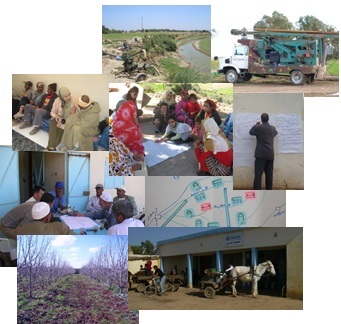Kawtar Rerhrhaye, Abdelkader Ait El Mekki
DOI: https://doi.org/10.60569/5-a5
Numéro 5 – octobre 2017
Résumé
L’objectif visé par cet article est d’analyser, d’une part, le taux de couverture des besoins de consommation en blé tendre par la production nationale et, d’autre part, le coût d’intervention de l’Etat sur l’ensemble de la filière depuis le lancement du Plan Maroc Vert. La finalité recherchée est de mettre en évidence l’efficience des choix politiques en tant qu’élément de la gouvernance de cette filière, face aux menaces potentielles du marché international et face à la nécessité d’assurer la sécurité alimentaire. Les résultats obtenus montrent une amélioration du taux de couverture de la demande de consommation par la production nationale, qui est passé de 42,3 % en 2008 à 58,6 % en moyenne de la période comprise entre 2009 et 2016. Il faut noter toutefois que les conditions climatiques ont été globalement favorables, soit 364 mm en moyenne interannuelle de pluviométrie entre 2008-2016, ce qui rend difficile l’appréciation de l’intervention de l’Etat. En même temps, malgré l’importance des objectifs tracés dans le cadre du Plan Maroc Vert pour améliorer la productivité, les coûts budgétaires engendrés par la politique de soutien à ladite filière restent élevés avec un montant moyen de 2,7 milliards de dirhams par an depuis le lancement du Plan Maroc Vert. Les efforts visant l’amélioration de la productivité notamment dans les zones en bour devraient donc être renforcés à travers des programmes de recherche/développement dans le processus d’utilisation des paquets technologiques appropriés (profil variétal des semences certifiées, multiplication des semences, meilleure utilisation des fertilisants et des traitements phytosanitaires en particulier en zone bour où les conditions climatiques sont plus variables, mécanisation des travaux du sol, semis mécanique direct, etc.). Le but est de réduire au maximum le degré de dépendance vis-à-vis des importations pour assurer la sécurité alimentaire en blé tendre du pays.
Mots clés : blé tendre, efficience, sécurité alimentaire, Plan Maroc Vert
كفاءة سياسات الدولة لضمان الأمن الغذائي في قطاع القمح الرطب في المغرب
ترصد هذه المقالة من ناحية اولى، تحليل معدل حاجيات استهلاك القمح الرطب من الانتاج الوطني، كما تتناول من ناحية ثانية، تحليل مجموع التكاليف المنفقة على هذا القطاع من طرف الدولة منذ إطلاق هذه الاخيرة لبرنامج المخطط الاخضر. والغاية من هذا الرصد، هو مقاربة خيارات الدولة، ومدى فعاليتها واستجابتها لشروط الكفاءة ومعايير الحكامة في مواجهة اكراهات السوق الدولية من جهة اولى، وتحقيق الامن الغذائي من جهة ثانية. ويتضح من خلال النتائج المحصل عليها ان ثمة ازدياد في معدل تغطية الطلب على الاستهلاك من الإنتاج الوطني وذلك بالمقارنة ما بين سنة 2008 (42, 3%) والمعدل المتوسط السنوي للفترة ما بين 2009-2016 58,6%) ) . كما ان تقييم تدخل الدولة كان ولابد وان نراعي فيه الاستفادة الواضحة من تحسن الظروف المناخية التي بلغت معدل سنوي للتساقطات قدره 364 ملم بين عامي 2008-2016. وتجدر الاشارة الى انه رغم اهمية الاهداف المتوخاة في إطار المخطط الأخضر للرفع من الانتاجية تبقى سياسة الدعم المخصصة لهذا القطاع مكلفة لميزانية الدولة بمعدل سنوي متوسط يقدر ب 2,7 مليار درهم ما بين 2009-2016. وعلى ضوء ذلك فان ثمة مقترحات وتوصيات عملية لتحسين الإنتاجية، لخصت في ضرورة تعزيز الجهود المبذولة ولا سيما في المناطق ذات معدلات الخصوبة المرتفعة خصوصا في مناطق البور حيث تكون الظروف المناخية أكثر تغيرا وذلك بتبني برامج للبحث والتطوير في استخدام التكنولوجيا المناسبة (اختيار اصناف جيدة للبذور بشكل متكاثر، استخدام أفضل للأسمدة، معالجة الصحة النباتية، مكننة وسائل الحرث، البذر الميكانيكي المباشر وما إلى ذلك). بما يؤدي الى خفض درجة الاعتماد على الواردات وضمان الأمن الغذائي.
الكلمات المفتاحية: القمح اللين، الكفاءة، الأمن الغذائي، مخطط المغرب الأخضر
Efficiency of State Policies for Soft Wheat Food Security in Morocco
Abstract
The aim of this article is to analyze, on the one hand, the rate at which national production covers the consumption needs for soft wheat, and on the other hand, the cost of State intervention across the entire value chain since the launch of the Green Morocco Plan. The objective is to highlight the efficiency of policy choices as a component of the governance of this value chain, in the face of potential threats from the international market and the need to ensure food security. The results show an improvement in the coverage rate of consumption demand by national production, which increased from 42.3% in 2008 to an average of 58.6% over the period 2009–2016. However, it should be noted that climatic conditions were generally favorable, with an average annual rainfall of 364 mm between 2008 and 2016, which makes it difficult to fully assess the impact of State intervention. At the same time, despite the ambitious objectives set under the Green Morocco Plan to improve productivity, the budgetary costs generated by the support policy for this value chain remain high, amounting to an average of 2.7 billion dirhams per year since the Plan’s launch. Efforts to improve productivity, particularly in rainfed areas, should therefore be strengthened through research and development programs promoting the use of appropriate technological packages (certified seed varietal profiles, seed multiplication, better use of fertilizers and phytosanitary treatments—especially in rainfed zones where climatic conditions are more variable—soil mechanization, direct mechanical seeding, etc.). The goal is to minimize the level of dependence on imports in order to ensure the country’s food security in soft wheat.
Keywords: soft wheat; efficiency; food security; Green Morocco Plan
